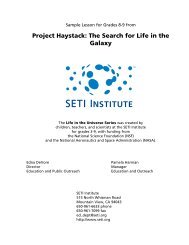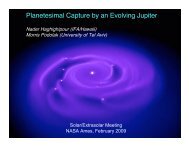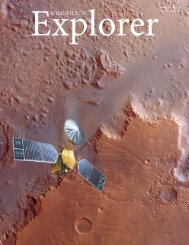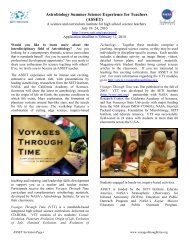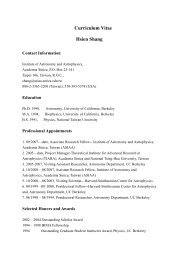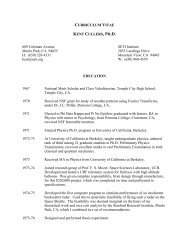SETI Institute Frequently Asked Questions To help you quickly find ...
SETI Institute Frequently Asked Questions To help you quickly find ...
SETI Institute Frequently Asked Questions To help you quickly find ...
- No tags were found...
You also want an ePaper? Increase the reach of your titles
YUMPU automatically turns print PDFs into web optimized ePapers that Google loves.
houses this sophisticated electronics in a Mobile Research<br />
Facility (MRF), which is a $500,000, customized<br />
facility container. This container can be shipped<br />
by land, sea or air to the telescope site and plugged in.<br />
In order to <strong>quickly</strong> verify whether a signal is truly<br />
extraterrestrial or merely earthly interference, Project<br />
Phoenix always uses a second, generally smaller<br />
telescope located hundreds of miles from the primary<br />
instrument.<br />
Project Phoenix has just concluded more than a year<br />
of operations at the 140 foot telescope of the National<br />
Radio Astronomy Observatory in Green Bank, West<br />
Virginia, using a second telescope in Woodbury,<br />
Georgia. The equipment is now being transported to<br />
Arecibo, Puerto Rico, where the search will continue<br />
in September, 1998. The second telescope for these<br />
observations is located at Jodrell Bank, near Manchester,<br />
England.<br />
Note that the observations can be controlled remotely<br />
from the <strong>Institute</strong> headquarters in Mountain View,<br />
California. The signal processing equipment must be<br />
situated at the main telescope, however.<br />
El proyecto <strong>SETI</strong> se lleva a cabo en los<br />
radiotelescopios más grandes disponibles. Esto<br />
incluye antenas en Australia, Virginia Occidental y<br />
Puerto Rico. Además de estos grandes telescopios, la<br />
búsqueda <strong>SETI</strong> requiere utilizar un procesador digital<br />
de señal especializado. El equipo Phoenix alberga<br />
esta sofisticada electrónica en la Instalación Móvil de<br />
Investigación (MRF), un contenedor adaptado de<br />
500.000 dólares. Este contenedor puede enviarse por<br />
tierra, mar o aire a cualquier radiotelescopio y<br />
simplemente “enchufarlo” al mismo.<br />
Para verificar rápidamente si una señal es realmente<br />
extraterrestre o sólo una interferencia terrestre, el<br />
proyecto Phoenix emplea un segundo telescopio,<br />
generalmente menor, a cientos de kilómetros del<br />
instrumento primario.<br />
El proyecto Phoenix acaba de terminar más de un año<br />
de operaciones en el telescopio de 140 pies del<br />
Observatorio Radioastronómico Nacional en Green<br />
Bank, Virginia Occidental, apoyado por un segundo<br />
telescopio en Woodbury, Georgia. El equipo se está<br />
transportando ahora a Arecibo, Puerto Rico, donde la<br />
búsqueda continuará en septiembre de 1998. El<br />
segundo telescopio para estas observaciones será el de<br />
Jodrell Bank, cerca de Manchester, en Inglaterra.<br />
How much does Project Phoenix cost<br />
Phoenix costs between $4 and $5 million per year.<br />
How long have astronomers been looking for extraterrestrial<br />
signals<br />
The first scientific paper on using radio waves to<br />
transmit information over interstellar distances was<br />
published in the magazine Nature in 1959 by physicists<br />
Phillip Morrison and Giuseppe Cocconi. In the<br />
following year, Frank Drake (now president of the<br />
<strong>SETI</strong> <strong>Institute</strong>) conducted the first radio search for<br />
evidence of technology in other solar systems using<br />
an 85-foot antenna at the National Radio Astronomy<br />
Observatory in Green Bank, West Virginia. Drake<br />
called his search Project Ozma, and observed two<br />
sun-like stars which are about 12 light years away.<br />
Since then, more than 60 searches have been conducted<br />
by dozens of astronomers in several countries.<br />
However, note that the technology of today's searches<br />
dwarfs that of earlier efforts. Project Phoenix is estimated<br />
to be 100 trillion times more effective than<br />
Project Ozma.<br />
Project Phoenix is the only targeted star search now<br />
Obsérvese que las observaciones pueden realizarse a<br />
control remoto desde el Instituto <strong>SETI</strong> en Mountain<br />
View, California. No obstante, el equipo de<br />
procesamiento de la señal debe estar situado en el<br />
telescopio principal.<br />
¿Cuánto cuesta el proyecto Phoenix<br />
El proyecto Phoenix cuesta de 4 a 5 millones de<br />
dólares USA al año.<br />
¿Cuánto hace que los astrónomos buscan señales<br />
extraterrestres<br />
El primer documento científico sobre el uso de ondas<br />
de radio para transmitir información a distancias<br />
interestelares fue publicado en la revista Nature, en<br />
1959, por los físicos Phillip Morrison y Giuseppe<br />
Cocconi. Al año siguiente, Frank Drake (que en la<br />
actualidad es el presidente del Instituto <strong>SETI</strong>) realizó<br />
la primera radiobúsqueda en busca de tecnología en<br />
otros sistemas solares usando la antena de 85 pies del<br />
Observatorio Radioastronómico Nacional de Green<br />
Bank, Virginia Occidental. Drake llamó a su<br />
búsqueda proyecto Ozma, y logró observar dos<br />
estrellas del tipo del sol a 12 años luz de distancia.<br />
Desde entonces, más de 60 búsquedas se han<br />
realizado por docenas de astrónomos en varios países.




